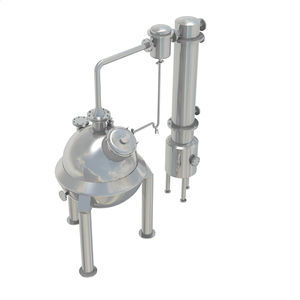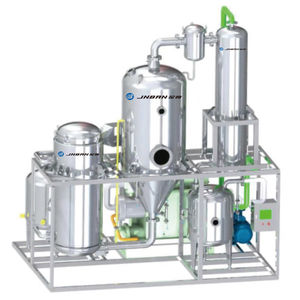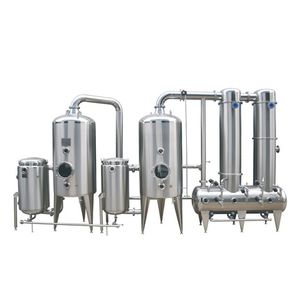
- Industrial machines and equipment
- Heat Exchanger and Refrigeration
- Shell and tube evaporator
- Wenzhou Jinbang Light Ind Machinery Co., Ltd
- Company
- Products
- Catalogs
- News & Trends
- Exhibitions
Thermal evaporator JBMVR-01vacuumfalling filmshell and tube


Add to favorites
Compare this product
Characteristics
- Type
- thermal, vacuum, falling film, shell and tube, forced circulation, thin-film, short path
- Laboratory/process
- process
- Applications
- for liquids, for the food industry, for sample concentration, for wastewater treatment, for solvents, for dairy products, for liquid waste
- Other characteristics
- automatic, low temperature, electric, explosion-proof, Evapo-concentration
Description
Key Components and Working Principle
The primary components of a falling film evaporator include:
Heating Tubes or Plates: These provide the surface on which the liquid film forms and evaporates.
Distributor: Ensures even distribution of the liquid onto the heating surface.
Vapor Separator: Separates the vapor from the concentrated liquid.
Condenser: Condenses the vapor into a liquid form for collection or further processing.
The working principle involves feeding the liquid at the top of the evaporator, where it is evenly distributed onto the heating surfaces. As the liquid flows down, it forms a thin film and is heated by the steam or hot water within the tubes or plates. This causes the solvent to evaporate, leaving behind a more concentrated solution. The vapor is then separated and condensed for collection.
Applications of Falling Film Evaporators
Falling film evaporators are used in diverse industries for various applications, including:
Food and Beverage: Concentration of fruit juices, milk, and other dairy products while preserving flavor and nutritional content.
Chemical: Concentration of chemical solutions, removal of solvents, and recovery of valuable compounds.
Pharmaceutical: Concentration of active pharmaceutical ingredients (APIs) and other heat-sensitive compounds.
Environmental: Treatment of wastewater and recovery of valuable materials from effluents.
Renewable Energy: Concentration of biofuels and other renewable energy sources.
Advantages of Falling Film Evaporators
High Efficiency,Low Operating Temperatures,Energy Savings,Flexibility,Scalability
VIDEO
Catalogs
No catalogs are available for this product.
See all of Wenzhou Jinbang Light Ind Machinery Co., Ltd‘s catalogsOther Wenzhou Jinbang Light Ind Machinery Co., Ltd products
concentration equipment
Related Searches
- Vessel
- Storage vessel
- Heat exchanger unit
- Inox vessel
- Cylindrical vessel
- Vertical vessel
- Industrial vessel
- Liquid/liquid heat exchanger
- Liquid vessel
- Water vessel
- Vessel for food applications
- Horizontal vessel
- Tubular heat exchanger
- Pressure tank
- Stainless steel heat exchanger
- Vessel for chemical applications
- Gas/liquid heat exchanger unit
- Vessel for pharmaceutical applications
- Water tank
- Transporting tank
*Prices are pre-tax. They exclude delivery charges and customs duties and do not include additional charges for installation or activation options. Prices are indicative only and may vary by country, with changes to the cost of raw materials and exchange rates.

































